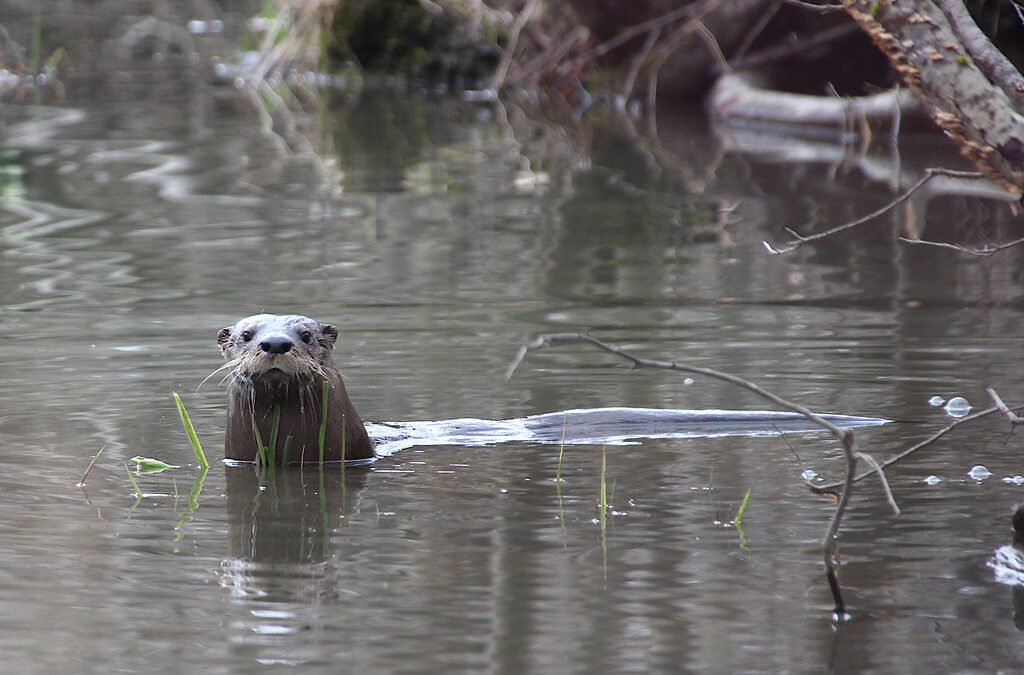By Chelsea Jandreau
There are plenty of animals I have never seen in real life, including many that call Western New York home. In most cases, I am absolutely fine with this. Life goes on and if I ever happen to come across a new plant, fungus or animal, it is just an extra bonus of my time outside. I say most however, because there is one animal that I have never spotted and am somewhat bitter about it. That animal is the North American River Otter. I have seen plenty of Sea Otters, but I have never found that elusive, to me at least, River Otter.
I am aware that this is largely my own fault, as I do not tend to put myself in the right place or at the right time to see them. There are times of the year when River Otters are at Audubon Community Nature Center’s property. This is a fact confirmed by the sightings and photos of other visitors and staff members. Despite being there most days of the week, I am not often out at the best time or place to find this particular animal.
They seem to make an appearance more in the winter than in the summer. River Otters are active throughout the winter and have warm, water-repellent fur to keep them warm as they hunt for prey in the ponds. If I follow the patterns of other people’s sightings, I am more likely to see them if I drag myself out of bed earlier in the morning and walk around the far side of the property.
Part of spotting animals is setting yourself up for success. With research and some exploration, you often get a better understanding of where animals may be and figure out what habitats they frequent throughout the year.
If you are looking for salamanders in the spring, looking under logs may be helpful, but keeping track of weather and temperature can help you figure out when they begin their trek to vernal pools and other small bodies of water en masse to lay their eggs. If you are looking for a Tundra Swan in this area, you will likely only find them in the fall or spring as they migrate. Some animals, like muskrats, are mostly found near ponds while others, such as squirrels and Blue Jays can be found in just about any habitat, urban or rural.
If you want to see animals in the wild, it is important to be quiet and move slowly. Sometimes you will see signs of an animal instead of the animal itself. In the case of my mysterious River Otters, it is sometimes easier to spot tracks in the snow or holes leading to dens on the riverbanks during the summer than it is to find the otter itself.

Many animals will disappear or move away when they see or hear human activity. Sometimes you see the ripples left on the surface of the pond, or hear the animal crashing through the brush. White-tailed Deer do their best to camouflage, but they are also loud when they are running through brush, so this makes them easier to find. Chipmunks and squirrels are also loud moving along the leaf litter of the forest. Frequently you hear a bird before or instead of seeing it.
Another large part of spotting a specific animal is persistence and the rest of it is up to luck. Some elusive animals are difficult to find because they are small, others are secretive and do their best to hide from humans, and certain species are just uncommon or only live in remote areas without much human impact. You may have to repeatedly go out into the woods to look and listen for a certain bird or search the ground for a specific fungus. If you are looking for a specific organism, you are not always going to see it the first try, or even the second or third. Sometimes you just have to keep trying, see what else you find along the way and wait patiently for the day it appears.
If I want to see a River Otter, it might take more intentional and repeated effort. On the other hand, those River Otters occasionally show up in the backyard pond, so maybe one day I will just get lucky.
If you are one of those looking to spot your own elusive animal, remember to treat those animals and their habitats with respect. It can be harmful to some critters if large groups of people are tromping through their habitat or are getting too close. This is why those who know where that Snowy Owl or uncommon orchid is found won’t always give out the location. Sometimes, you have to leave nature to do its own thing, unencumbered by crowds.

This all makes me wonder about how many other animals, plants and parts of nature I never see that I am entirely unaware of. When going into nature, I alternate between being attentive and observant of my surroundings and being entirely unaware of what is going on around me. As for the otters, maybe one day I’ll finally find them. Until then, I’ll just enjoy whatever else comes my way as I walk around the woods, marshes and fields.
Audubon Community Nature Center builds and nurtures connections between people and nature. ACNC is located just east of Route 62 between Warren and Jamestown. The trails are open from dawn to dusk and birds of prey can be viewed anytime the trails are open. The Nature Center is open from 10 a.m. until 4:30 p.m. daily except Sunday when it opens at 1 p.m. More information can be found online at auduboncnc.org or by calling (716) 569-2345.


Recent Comments